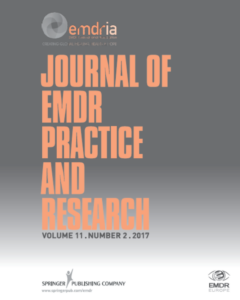Trauma resolution: A healing journey through EMDR therapy (Springer, 2024)
This chapter on EMDR therapy appears in an edited book offering an integrative and evidence-based practice approach to training in psychotherapy, examining common factors across different therapeutic models seen through an attachment theory lens.
Read MoreFactors influencing quality of processing in EMDR therapy (Frontiers in Psychology)
This study presents a preliminary analysis of a new instrument oriented at the analysis of processing in EMDR trauma therapy, the Processing Difficulties Scale (PDS).
Read MoreEye movement desensitization reprocessing (EMDR) therapy as a rapid therapeutic method for psychological trauma and other mental health disorders: A critical review (International Journal for Psychotherapy in Africa)
This paper examines the effect of EMDR therapy as a rapid therapeutic method for the treatment of psychological trauma.
Read MoreCost-effectiveness analysis of the treatment of posttraumatic stress disorder related to childhood abuse: Comparison of phase-based treatment and direct trauma-focused treatment (Frontiers in Psychology)
This study compared the cost-effectiveness of a phased-based treatment approach with direct trauma-focused treatment in patients with PTSD and a history of childhood abuse.
Read MoreIndividual treatment selection for patients with post-traumatic stress disorder: External validation of a personalised advantage index (Psychotherapy Research)
This study explores the option of machine learning models to recommend types of PTSD treatment to patients based on potential individual differences, and highlights the need for external validation of machine learning models.
Read MoreThe evolution and future of eye movement desensitization and reprocessing therapy (BJPsych Advances)
This article discusses EMDR therapy’s underlying model, adaptive information processing (AIP), treatment categories within EMDR, and EMDR training and credentialing.
Read MoreEfficacy of EMDR in Body Dysmorphic Disorder and Associated Cognitive-Emotional Features (Journal of EMDR Practice and Research)
Efficacy of EMDR in body dysmorphic disorder symptoms and features like appearance-based rejection sensitivity, body shame, & self-compassion.
Read MoreThe Effectiveness and Tolerability of an Intensive Outpatient Trauma Treatment Program for Adolescents With PTSD (Journal of EMDR Practice and Research)
Efficacy of outpatient trauma treatment program using prolonged exposure (PE) and EMDR for adolescents with PTSD.
Read MoreEye movement intervention facilitates concurrent perception and memory processing (Cerebral Cortex)
This article utilized EEG scans to look at neural activity during eye movements and suggested information facilitation is important in EMDR therapy.
Read MoreEye-movement desensitization and reprocessing (Routledge, 2024)
This chapter illustrates similarities in EMDR and memory reconsolidation, in Unlocking the emotional brain: Memory reconsolidation and the psychotherapy of transformational change.
Read More



